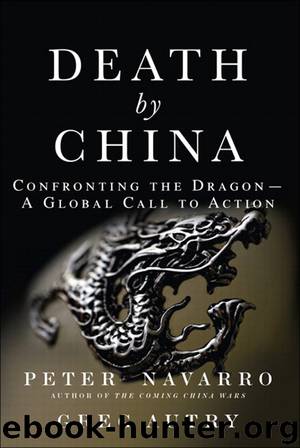Death by China (Pioneer Panel's Library)

Author:Peter W. Navarro & Greg W. Autry
Language: eng
Format: epub
Published: 2011-06-16T16:00:00+00:00
A Mining Cornucopia
What China also seeks in space is the valuable array of precious metals and raw materials that reside in the crusts of both the moon and numerous near-Earth asteroids. This bounty ranges from gold and platinum to extremely rare metals critical to high-tech manufacturing.
In fact, successful mining operations in space would do much to alleviate growing raw material shortages and the pollution associated with resource extraction. Consider, for example, Asteroid 433, otherwise known as Eros. Scientists writing in the journal Nature have predicted159 that in a fortunately distant future, this giant, 34-kiloton chunk of rock is likely to hit our planet and cause a disaster bigger than the impact that wiped out the dinosaurs some 65 million years back. The good news, however, is that Eros is jam-packed with all manner of mineral wealth just waiting for some enterprising space station to extract. Moreover, with its light gravity and a total lack of environmental constraints, extracting raw materials from Eros with freely available solar energy would be relatively simple once the transportation is in place. Nor is this completely sci-fi, as a NASA space probe visited Eros in the year 2000 and landed on it in 2001.
And here’s a radical idea that has been proposed by private space entrepreneur Jim Benson for both avoiding the calamity of a collision with Earth and getting Eros’s mineral bounty back to our planet: Attach rockets to the asteroid160 to gently adjust its orbit. In this way, it would eventually be possible to bring Eros into a steady position within our Earth-moon system and thereby eliminate any threat of a collision. Of course, this scenario begs the question as to who will get there first and plant their flag—and steering rockets—on resources like Eros.
Nor is it just raw materials like aluminum, gold, and zinc that China may seek in space. From the Chinese perspective, the even bigger lunar prize in the shorter term may well be realizing the enormous potential of nuclear fusion energy. Unlike the current problematic nuclear fission power plants, fusion energy would be both clean and safe and truly be “too cheap to meter.” And here’s the lunar connection: An ingredient that many physicists believe could bring fusion within reach is Helium 3—an extremely rare isotope thought to be abundant on the moon.
As China’s moon czar has framed the potential of Helium 3: “Each year, three space shuttle missions161 could bring enough fuel for all human beings across the world.” Mr. Ouyang might well have added that the successful development of fusion energy from moon-based materials would be a death blow to the OPEC oil cartel and a magic bullet against global warming.
Chinese visionaries like Ouyang also see the moon162 as offering a free and virtually nightless environment in which to generate solar power up to eight times more efficiently and then beam it back to Earth. Science fiction, you say? Yes, indeed. Just like walking on the moon or talking to anyone anywhere on Earth from a handheld device.
Download
This site does not store any files on its server. We only index and link to content provided by other sites. Please contact the content providers to delete copyright contents if any and email us, we'll remove relevant links or contents immediately.
The Meaning of the Library by unknow(2532)
Six Billion Shoppers by Porter Erisman(2280)
Why Nations Fail: The Origins of Power, Prosperity, and Poverty by Daron Acemoglu & James Robinson(2254)
No Time to Say Goodbye(2080)
Red Notice by Bill Browder(2044)
The Economist [T6, 22 Thg9 2017] by The Economist(1901)
Currency Trading For Dummies by Brian Dolan(1899)
Thank You for Being Late by Thomas L. Friedman(1751)
Bitcoin: The Ultimate Guide to the World of Bitcoin, Bitcoin Mining, Bitcoin Investing, Blockchain Technology, Cryptocurrency (2nd Edition) by Ikuya Takashima(1674)
Amazon FBA: Amazon FBA Blackbook: Everything You Need To Know to Start Your Amazon Business Empire (Amazon Empire, FBA Mastery) by John Fisher(1550)
Coffee: From Bean to Barista by Robert W. Thurston(1503)
The Future Is Asian by Parag Khanna(1460)
The Great Economists by Linda Yueh(1439)
How Money Got Free: Bitcoin and the Fight for the Future of Finance by Brian Patrick Eha(1401)
Grave New World by Stephen D. King(1397)
Pocket World in Figures 2018 by The Economist(1397)
Capitalism Without Capital: The Rise of the Intangible Economy by Jonathan Haskel(1381)
The Sex Business by Economist(1361)
Cultural Intelligence by David C. Thomas(1273)
